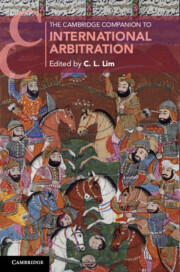Book contents
- The Cambridge Companion to International Arbitration
- Cambridge Companions to Law
- The Cambridge Companion to International Arbitration
- Copyright page
- Dedication
- Contents
- Contributors
- Foreword
- Preface
- Treaties, National Legislation, Cases and Awards
- Part I The History, Doctrines and Sociology of the Growth of Transnational Justice
- 1 Development of the Principal Forms from Antiquity to Arbitromania
- 2 Dealing in Virtue
- Part II International Commercial Arbitration as a Transnational Justice System
- Part III Investor-State Arbitration
- Part IV Inter-State Arbitration and the Pursuit of Peace
- Part V Systemic, Trans-Substantive and New Issues
- Index
1 - Development of the Principal Forms from Antiquity to Arbitromania
from Part I - The History, Doctrines and Sociology of the Growth of Transnational Justice
Published online by Cambridge University Press: 08 October 2021
- The Cambridge Companion to International Arbitration
- Cambridge Companions to Law
- The Cambridge Companion to International Arbitration
- Copyright page
- Dedication
- Contents
- Contributors
- Foreword
- Preface
- Treaties, National Legislation, Cases and Awards
- Part I The History, Doctrines and Sociology of the Growth of Transnational Justice
- 1 Development of the Principal Forms from Antiquity to Arbitromania
- 2 Dealing in Virtue
- Part II International Commercial Arbitration as a Transnational Justice System
- Part III Investor-State Arbitration
- Part IV Inter-State Arbitration and the Pursuit of Peace
- Part V Systemic, Trans-Substantive and New Issues
- Index
Summary
International arbitration differs from domestic arbitration. As Jan Paulsson puts it, ‘international arbitration is no more a “type” of arbitration than a sea elephant is a type of elephant’.1 Yet as with sea elephants there are different species of international arbitration. This book is about how the lines by which international arbitration’s principal forms – in the contexts of commercial disputes, disputes between a foreign investor and a State, disputes purely between States, and even between the State and its constituent part – grew separately but whose growth joined and overlapped.2 One misconception should perhaps be dispelled at the outset; that the classifications just mentioned depend upon the identity or status of the parties. For States too, and not just private parties, may become involved in an international commercial dispute. Not just with non-State, private actors but also between themselves. The distinction that matters lies instead in the precise legal relationship giving rise to the dispute submitted to arbitration. Less rare is a dispute under a foreign investment contract between a State and a private party which is submitted to arbitration seated in a neutral place or to ‘delocalised’ International Centre for the Settlement of Investment Disputes (ICSID) arbitration. Thus, for the purposes of this Companion, an inter-State arbitration, properly called, is one whose applicable law is public international law. In the case of intra-State arbitration the precise nature of the parties’ legal relationship – whether that is a matter of domestic law, even domestic private law, or public international law – may form a large part of the issue.
- Type
- Chapter
- Information
- The Cambridge Companion to International Arbitration , pp. 3 - 37Publisher: Cambridge University PressPrint publication year: 2021
- 1
- Cited by

